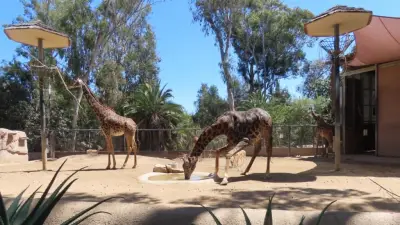Opinion: How a gift of giraffes in 1938 helped make the San Diego Zoo

Giraffes at the San Diego Zoo. (Photo by Rocky Smolin/Special to Times of San Diego) This did not start out as a book review. But when an opportunity arose to visit the San Diego Zoo last week after several years, I remembered the book West with Giraffes, a historical novel by Lynda Rutledge, and so was drawn to the giraffe habitat. Besides making me a fanatic admirer of one of the most astonishing animals on the planet, the book has a deep San Diego connection. The year was 1938, and Americans were continuing to suffer from the Great Depression just as world events in Europe were in crisis under Adolph Hitler’s aggression. Under directions from San Diego Zoo director Belle Benchley, who was the first female zoo director in the world and was known fondly as Boss Lady, two giraffes were acquired and transported by ship from East Africa to New York. En route, the ship encountered a vicious hurricane that nearly destroyed the vessel, but it miraculously arrived in New York harbor with the two giraffes still alive. After one giraffe’s injuries from the rough sea crossing were addressed, the two animals were confined in quarantine for 15 days before embarking in mid-October of 1938 on their 12-day cross-country road adventure along the famous Lee Highway. San Diego Zoo head keeper Charley Smith greeted the giraffes upon arrival on U.S. soil and accompanied them on the harrowing journey across the nation to deliver them to Benchley in San Diego on October 17, 1938. As they traveled, the giraffes in their specially designed carrier truck reportedly made quite a stir among citizens who had never before seen such amazing creatures. According to historical zoo records, Lofty and Patches lived at the San Diego Zoo for nearly 30 years and had seven offspring. Benchley herself was quite a character, beloved by employees and animals alike. Hired first as a bookkeeper by zoo founder Dr. Harry Wegeforth, Benchley helped him form the Zoological Society of San Diego and together they partnered in their commitment to create a world-class zoo. Giraffes are the tallest land animals in the world, with males reaching a height of 16 to 18 feet and females typically 14 to 16 feet tall. Their necks can be six to seven feet long. Today, giraffes are endangered and facing extinction due to loss of habitat, drought caused by climate change, and challenges with human-wildlife coexistence, according to the San Diego Zoo Wildlife Alliance. With their graceful stride, long eyelashes and beautiful spotted coats, these gentle giants (although we learned from the book that they do pack a ferocious kick when agitated) continue to fascinate. Giraffes are a wonder of nature. Conservation efforts As I’ve grown more aware of what we have done to the animals on our planet and how we have systemically — either unwittingly or deliberately — contributed to the destruction of natural environments that sustained animal life, zoos have presented a moral dilemma. As zoos go, the San Diego Zoo, with our Goldilocks weather, allows animals to live in habitats that challenge traditional memories of animals in glorified cages. Yet, seeing cheetahs and jaguars and lions in enclosures, however nice, still depresses me. For animals that can run like the wind, it’s sad to see them lying down. Being active just means they pace — not the same as running after prey — or, as I like to think, just running for the love of it. Keeping animals in captivity saddens me. But the sadness lessens knowing the San Diego Zoo organization does much more than just offer a spectacle for observers. The zoo’s considerable conservation efforts appease my conscience. The mission of the San Diego Zoo Wildlife Alliance is “saving species worldwide by uniting our expertise in wildlife care and conservation science with our dedication to inspiring passion for nature.” Join the alliance by donating to www.sdzwa.org. Marsha Sutton is an education writer and opinion columnist and can be reached at [email protected]. Want to submit a letter to the editor, guest column or opinion piece? Find our guidelines and submission form here.


